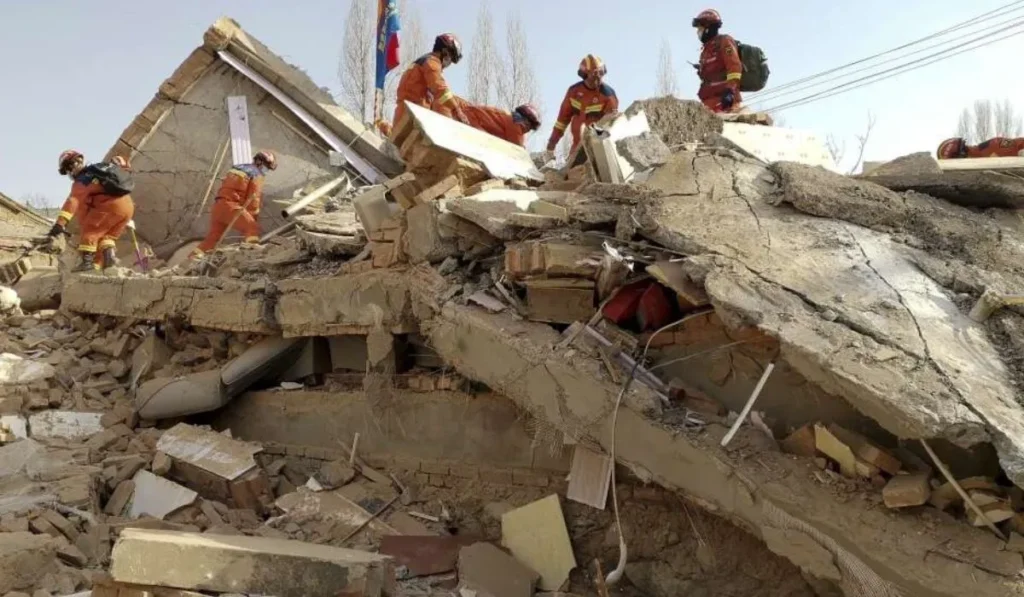
On the evening of Monday, a powerful earthquake with a magnitude of 6.2 jolted the northwestern region of Gansu province in China. As of Thursday, there were still a dozen individuals missing for intensifying the anxiety and concern of their loved ones.
Reports from Chinese media outlets have indicated that the search and rescue operations in Gansu province were concluded by 3 p.m. local time (0700 GMT) on Tuesday. This was approximately 15 hours following the onset of the calamitous earthquake that struck a secluded and hilly region near the border shared by Gansu and Qinghai provinces.
#Update The death toll of the 6.2-magnitude earthquake in Northwest China's Gansu province has risen to 105. pic.twitter.com/Dd3wnyXU6Z
— China Daily (@ChinaDaily) December 19, 2023
The status of the search and rescue operations in Qinghai province remains uncertain at this time. Despite the flurry of activity and updates from Gansu province, information about the ongoing efforts in the neighbouring Qinghai has not been as forthcoming. This lack of clarity has left observers, both within and outside China, in a state of ambiguity regarding the progress of the rescue operations in Qinghai.
As of Wednesday morning at 9 a.m. local time (0100 GMT), the devastating earthquake in Gansu province had resulted in the tragic loss of 113 lives, according to official reports. In addition to this, a staggering number of 782 individuals have suffered injuries of varying degrees due to the calamity.
The authorities in Gansu have been meticulously carrying out search and rescue operations since the disaster struck. As a result of these comprehensive search operations, Gansu province has not reported any individuals as missing.
The 6.2-magnitude earthquake that jolted China's Gansu at midnight Monday has killed 131 people in Gansu and neighboring Qinghai Province, said local authorities. pic.twitter.com/bFLNHzM73u
— China Xinhua News (@XHNews) December 20, 2023
In the region adjacent to Qinghai, a tragic incident unfolded. On Wednesday, precisely at 8:56 p.m., the situation had escalated to a point where the death toll had unfortunately risen to 22. In addition to this, there were 198 individuals who had sustained injuries of varying degrees. Furthermore, there were 12 people whose whereabouts were still unknown, adding to the gravity of the situation. The authorities and rescue teams were working tirelessly to provide aid and locate the missing individuals.
Province of Gansu, a calamitous event led to the destruction of a staggering number of homes. The count of residences that were severely damaged exceeded 207,000. In addition to this, close to 15,000 homes completely collapsed under the impact of the disaster. This catastrophic event had a profound effect on the local population. More than 145,000 individuals found themselves directly affected by this incident.
Online discussions revealed a sense of curiosity among internet users regarding the swift conclusion of rescue operations in Gansu. Many speculated that the harsh, sub-zero temperatures played a significant role in curtailing the duration of the so-called “golden period” – a critical window of opportunity typically spanning 72 hours post-disaster, during which the chances of finding survivors are at their highest.
“They would have been dead by the time they were found, even 24 hours is already too long. Outdoor temperatures are below minus 10 C,” a user on Chinese microblogging platform Weibo commented.
According to reports from local media, which cite research findings, individuals who find themselves trapped under debris in conditions where the temperature plummets to as low as -10° Celsius (14°F) are at a heightened risk of succumbing to rapid hypothermia.
Even if these individuals are not injured, the extreme cold significantly reduces their survival time. Researchers suggest that under such harsh conditions, a person might only be able to survive for a brief window of five to ten hours.
A number of users on the social media platform Weibo have been contemplating various factors that could have contributed to the swift conclusion of the rescue operations. One such factor that was frequently mentioned was the relatively limited scope of the search area.
Many of the affected families are Hui people who have lost their homes, crops and belongings due to these calamities.
A devastating earthquake struck Jishishan county in Gansu, China, just a minute before the stroke of midnight on Monday. The tremors were so powerful that they forced many residents to flee their homes and brave the freezing temperatures of the night.
On Wednesday, a glimmer of hope emerged as rescuers managed to pull several victims to safety. These brave individuals worked tirelessly, navigating through the rubble and debris, in a race against time to find survivors.
Survivors are confronted with a future filled with uncertainty. The harsh winter months loom ahead, bringing with them freezing temperatures that pose a significant challenge.
The earthquake’s impact extended far beyond the immediate destruction of homes. Vital infrastructure such as roads, power lines, and water supply systems have been severely damaged, disrupting essential services and further complicating recovery efforts.
Agricultural production facilities, which are the lifeblood of many local economies, have also been hit hard. This damage threatens the livelihoods of many residents and could lead to long-term economic challenges.
Moreover, the quake set off a series of land and mudslides, adding another layer of devastation. These slides swept through villages in Haidong, a region in Qinghai, causing further destruction and leading to numerous people being reported missing.
ALSO READ | Noa Argamani 26 not abducted by hamas but by Gazan civilian mob